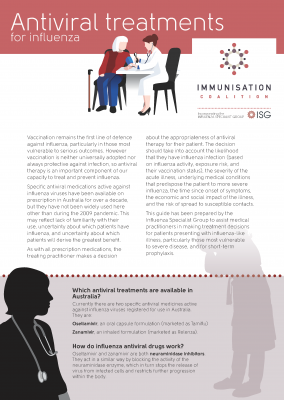About
 Vaccination remains the first line of defence against influenza. Particularly in those most vulnerable to serious outcomes, vaccination is neither universally adopted nor always protective against infection. So antiviral therapy is an important component of our capacity to treat and prevent influenza.
Vaccination remains the first line of defence against influenza. Particularly in those most vulnerable to serious outcomes, vaccination is neither universally adopted nor always protective against infection. So antiviral therapy is an important component of our capacity to treat and prevent influenza.
Specific antiviral medications active against influenza viruses have been available on prescription in Australia for over a decade, but they have not been widely used here other than during the 2009 pandemic. This may reflect lack of familiarity with their use, uncertainty about which patients have influenza, and uncertainty about which patients will derive the greatest benefit.
As with all prescription medications, the treating practitioner makes a decision about the appropriateness of antiviral therapy for their patient. The decision should take into account the likelihood that they have influenza infection (based on influenza activity, exposure risk, and their vaccination status), the severity of the acute illness, underlying medical conditions that predispose the patient to more severe influenza, the time since onset of symptoms, the economic and social impact of the illness, and the risk of spread to susceptible contacts.
This guide has been prepared by the Immunisation Coalition to assist medical practitioners with making treatment decisions for patients presenting with influenza-like illness, particularly those most vulnerable to severe disease, and for short-term prophylaxis.
A downloadable PDF of this guide is available here.
Which antiviral treatments are available in Australia?
Currently there are three specific antiviral medicines active against influenza viruses registered for use in Australia. They all belong to the family of neuraminidase inhibitors.
They are:
- Oseltamivir, an oral capsule formulation (marketed as Tamiflu)
- Zanamivir, an inhaled formulation (marketed as Relenza)
- Peramivir, an intravenous infusion (marketed as Rapivab)
How do influenza antiviral medicines work?
Neuraminidase inhibitors block the activity of the neuraminidase enzyme, which in turn stops the release of virus from infected cells and restricts further progression within the body.
When to use NIs
The neuraminidase inhibitors (NIs) are antiviral agents recommended for the treatment of influenza and some can also be used in prophylaxis.
Three NIs are currently registered in Australia:
- Oseltamivir (oral formulations)
- Zanamivir (inhaled presentation)
- Peramivir (Intravenous infusion).
NOTE: Amantadine from the Adamantanes group has been used in the past for treatment and prevention of influenza A, but it is no longer recommended for use due to high levels of resistance.
Treatment with NIs
Treatment with NIs is recommended for patients with confirmed or suspected influenza who require hospitalisation or are at risk of complications (including children <5 years, adults>=65 years, pregnant women, immunosuppressed patients or significant comorbidities), or have severe, complicated or progressive disease.
Treatment should commence within 48 hours of the onset of illness, and should not be delayed while awaiting laboratory test results*. Recommended duration of treatment is five days for both oseltamivir and zanamivir whereas peramivir is a single dose infusion.
For mild/moderate illness, treatment commenced beyond 48 hours is unlikely to be effective. However, for patients hospitalised with more severe respiratory tract infections, treatment can be commenced up to 4–5 days after onset and reduces the risk of progression of disease.[1] During the 2009 H1N1 pandemic a number of studies showed that early treatment of hospitalised patients reduced progression of disease and probably reduced mortality.
* Conventional laboratory tests usually do not provide results quickly enough to inform decisions about treatment. Point of care (POC) tests can be performed in the surgery/clinic or in the nearby laboratory though negative results should be treated with caution due to the low sensitivity of the antigen tests. Hospitalised patients with suspected influenza, should be tested using molecular assays with high sensitivity and specificity (e.g. RT-PCR) to confirm the need to pursue antiviral therapy or change the treatment therapy.[2]
1 Centres for Disease Control and Prevention. Influenza Antiviral Medications: Summary for Clinicians. Available at http://www.cdc.gov/flu/professionals/antivirals/summary- clinicians.htm. Accessed July 16th, 2019.
2 Seasonal Influenza Infection CDNA National Guidelines for Public Health Units, December 2017
Prophylaxis with NIs
Prophylaxis with NIs should be considered for contacts of a suspected or confirmed influenza case when at high risk of influenza complications. This is most relevant for control of institutional outbreaks, especially in high risk settings such as long-term residential care facilities. It can also be used for prevention of illness in high risk individuals who lack vaccine-induced protection. This includes those within two weeks of vaccination, severely immunosuppressed patients, and people who have contraindications to vaccination.[3] Oseltamivir and zanamivir are both approved for prophylaxis as they can effectively prevent symptomatic influenza.
Antiviral prophylaxis is most effective when given within 48 hours since the first exposure to a person with influenza and should be taken at least for 10 days.
Pregnant women are at risk of serious influenza illness and oseltamivir is considered the safest option for treatment and prophylactic use based on the studies currently available.
3 Influenza: overview on prevention and therapy. Christopher Robson, Sai Rupa Baskar, Robert Booy, Patricia E Ferguson, Nicole Gilroy, Jen Kok, Indy Sandaradura, Dominic Dwyer. Aust Prescr 2019;42:51-5. 3 June 2019
Side effects
Side effects of NIs are limited and generally mild. Oseltamivir may cause nausea, vomiting, headache and pain.[4] Zanamivir may cause gastrointestinal disturbances (diarrhoea, nausea), headache, dizziness and, because it is inhalational, it may also cause upper airways congestion, sinusitis, bronchitis and cough.[5] Peramivir may cause diarrhoea in adults and vomiting, fever and tympanic membrane erythema in paediatric patients.[6]
There have been post-marketing reports of rare transient neuropsychiatric events in children and adolescents for both oseltamivir and peramivir.
4 Oseltamivir, TGA Australian Public Assessment Report, https://www.tga.gov.au/sites/default/files/auspar-tamiflu. pdf
5 Zanamivir, Australian Product Information, (PI for ARTG ID 66962) http://www.ebs.tga.gov.au/ebs/picmi/ picmirepository.nsf/pdf?OpenAgent&id=CP-2010- PI-04928-3
6 Peramivir, TGA report, https://www.tga.gov.au/sites/default/ files/auspar-peramivir-181105.pdf
How effective are NIs?
If the NIs are commenced within 48 hours of onset of illness, they can reduce the duration of fever due to influenza by one day.[7] Most interestingly the use of NIs to prevent influenza in contacts of infected individuals, has shown an effectiveness of 70% to 90% in preventing influenza and is a useful adjunct to influenza vaccination.[8]
The NIs are active against all known influenza virus types and subtypes, including the A/H5N1 and A/H7N9 avian influenza viruses, but not against any other respiratory viruses. Resistance to oseltamivir is very low, but resistant strains do occasionally emerge and circulate within the community, though they are not sufficiently common to lead to a change in vaccine strain recommendations. Oseltamivir-resistant viruses usually only cause significant disease in immunocompromised patients. Resistance to zanamivir and peramivir is extremely rare.
7 Antiviral Medications in Seasonal and Pandemic Influenza, A Systematic Review November 2016, Regine Lehnert, Mathias Pletz, Annicka Reuss and Tom Schaberg, https://www.ncbi. nlm.nih.gov/pmc/articles/PMC5240024/
8 Information about influenza (flu) from the Australian Government, Department of Health; https://www.health. gov.au/health-topics/flu-influenza#who-is-at-risk
Immunisation Coalition recommendations
Antiviral treatment for seasonal influenza should be considered where the patient has clinical illness suggestive of influenza and a reasonable risk of exposure, i.e. either:
- it is during the local influenza season (noting that the influenza season in northern Australia often begins in January and local epidemics may occur during the summer months)
- they have recently travelled in areas with influenza activity
- they have had exposure to a known or likely influenza-infected person, e.g. during an institutional or travel-related outbreak.
If so, treatment with a neuraminidase inhibitor is:
- recommended for persons with mild/moderate illness at the time of consultation but who are at higher risk of influenza complications (as defined by Australian Department of Health[8]) and who are within 48 hours of onset of illness. Clinical judgment, on the basis of the patient’s disease severity and progression, age, underlying medical conditions, likelihood of influenza, and time since onset of symptoms, is important when making antiviral treatment decisions for high-risk outpatients. Prior vaccination does not preclude the use of antivirals.
- strongly recommended for patients with severe illness that is known or suspected to be due to influenza, up to 5 days after onset of illness. This includes anyone requiring hospitalisation and anyone who has progressive, severe or complicated illness. This decision should be independent of whether they have been vaccinated against influenza or their prior state of health. Only oseltamivir is recommended in these patients.
- to be considered for any previously healthy, symptomatic outpatient not at high risk with confirmed or suspected influenza if treatment can be initiated within 48 hours of illness onset. This should be based on clinical judgment of the likely benefits.
- recommended for prophylaxis of close contacts, particularly in household settings and institutional influenza outbreaks.
8 Information about influenza (flu) from the Australian Government, Department of Health; https://www.health. gov.au/health-topics/flu-influenza#who-is-at-risk
Current Australian licensed indications
All three NIs are indicated for the treatment of infections due to Influenza A and B viruses. While oseltamivir and zanamivir can be used for both treatment and prophylaxis, peramivir is limited to treatment only. Available formulations, length of treatment and dosage are summarised in the table on the attached, downloadable PDF.
